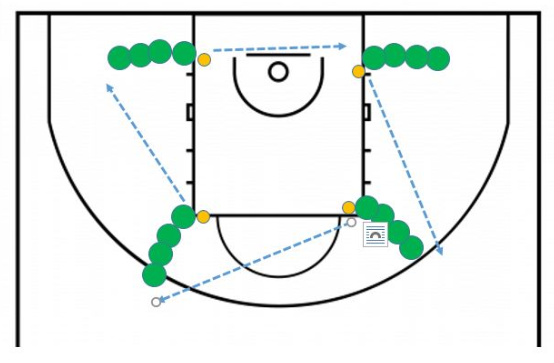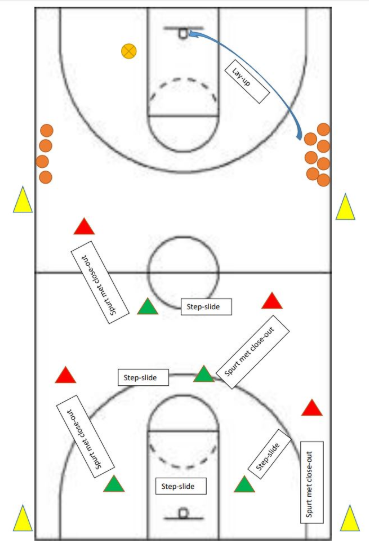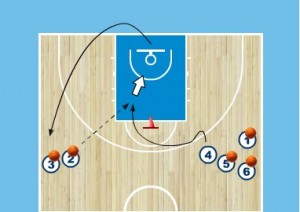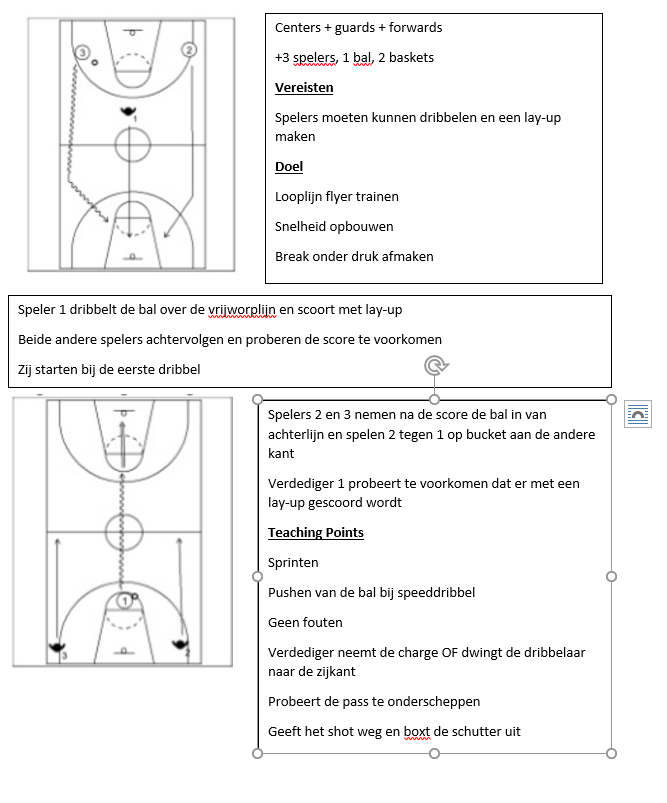Basketball drills
- Alternate between squatting and standing while dribbling.
- Dribble while sitting down and standing up again.
- Dribble while lying on your back; stand up while dribbling at the signal.
- Dribble while lying down and standing up again.
- 2 rows of which 1 row has the ball.
- Passes to the middle line from the middle line 1 vs 1.
- When passing, make sure the persons keep running straight and don't go sideways.
- free play on 1 or 2 baskets,
- depending on the number of players.
- NO dribbles only passing.
- We're gonna dribble!
- Dribble the ball from left to right.
- With feints in between. High. Low. Fast and slow.
- Look closely at the options you have.
- The planet Saturn is the planet with the rings.
- So can you guess how the Saturn exercise goes?
- Spin the ball around your left leg, your right leg and around both legs.
- There is no dribbling involved, but this exercise is very good for your hand-eye coordination.
This drill will help develop proper passing and shooting techniques. This drill also emphasizes communication between teammates
- Divide the team into four squads. One team on each block and one team on each elbow. Give each team one ball.
- The first person in each line shoots and follows his shot, passing it back to the next person in his line.
- After rebounding the ball, the shooter returns the ball to the line they were in and rotates clockwise to the end of the next spot. Rotations are shown in the diagram.
- All four lines work as a team and keep track of the total number of shots scored.
- Emphasize to the players that communication is very important in this drill.
- Players must make game-winning passes and their shots must also be taken at game level.
- The time limit of this exercise can be changed from five minutes to whatever you like or number of shots scored
- Also the spots on the court where the players shoot from can be varied

- Players start at the bottom of the baseline.
- The red cones are sprint.
- The green cones are step-slide.
- Then we either take the ball on the right side of the court or the left side.
- We start with the ball on the right side anyway.
- Do a lay-up, then lay the ball down on the left side of the court and sprint to the end line,
- and then start again,
- now laying down on the left side of the court, taking the ball there
- and then do a shot on the left side of the court,
- rebound and
- put the ball on the right side of the court
- and do the round again with the right side
- and then lay up there again.
- This exercise we repeat first round 3x, 15'' rest, 5x 30'' rest, 7x 45'' rest, 5x 30'' rest and finish again with 3x
End of exercise.
We keep on walking and don't walk. Rest period is provided between drills.

- One person shoots free throws.
- Two other players stand behind the one who throws the free throw.
- According to the rules of the game
- Once the ball is gone the three players go for the rebound.
- If the person who made the free throw has the ball, he can make another free throw.
- If he doesn't have the ball, the 2 other players go to the other side of the court to attack, 2 against 1.
- If attacker is pressured by defender then go to free man, otherwise keep going until lay-up.
- The next three players get ready to execute the exercise.
- Players stand ready at the halfway line. The first one has a ball (then 2 without the ball).
- X1 makes lay-up
- X2 takes rebound and passes in (after scoring!)
- X3 runs around the pot and starts defending
- X1 and X2 attack to the other ring
- variation: with 5
- X1 makes lay-up
- X2 takes rebound and gives in (after score!) to X3
- X3 dribbles over, X1 and X2 fill in the outer lines.
- X4 walks around the basket near the baseline and defends.
- X4 runs around the ball at the halfway line (other side) and defends.
This drill can serve well as a warming up drill (passing / finishing) but is also a good breakdown for a "scissor" play, or "split the post". You can expand the drill to include other options that may or may not be used in your set play. You start off basic, simple, and as your team is ready, you expand the exercise further and further.

- The exercise starts with two rows on two spots (e.g. 2 guard spots).
- If you have a larger team, you work on 2 baskets. Again, we would like to see everyone finish as many balls as possible.
- So make the groups as small as possible, but at least 4-6 players per basket.
- #1 starts the exercise by making a preliminary move ("setting up" the defender) and cutting tightly over the pawn (or chair).
- As a trainer you can also stand here for a while as a high-post so that it becomes recognizable for the players.
- #4 passes the ball to the cutting in #1 and after his pass he immediately makes another pre-move and cuts across the pawn in the same way, then gets the ball from #2.
- Rotation: Each player catches his own ball, and joins the line from which he received the ball. The exercise continues in this manner continuously.
Variations:
- Vary speed. The players must first master the technique of cutting in. Set up a man, push off and accelerate, etc. (see teaching points). Then increase the pace.
- Receive and shoot the ball;
- Make a pop-out (when a defender passes underneath) and shoot;
- Train aggression with pad, unbalance players when cutting in;
- After cutting in, offer the ball at the low post and finish with a post move (also think of countermoves), use pads here too;
- Work with a high-post player (trainer or one of the players): Pass the ball to the high-post first and then: hand-off / hi-lo, etc (depending on your own options);
- Eventually work with defenders involved as well;
Teaching Points:
- Set up defenders;
- Push off on the outer foot and accelerate (change of direction = change of speed)
Aggressive cutting in!
- Cut straight over the pawn, do not make wide turns ("shoulder to shoulder");
- Communication in the passing game, seeking eye contact, clearly asking for the ball with the front hand, asking in front of the man and running into the ball;
- Finish from the left side with the left hand, and the same applies for the right side;
- three groups of two per basket
- try to make qualitatively equal pairs
- How?
- 1 pair in front, 2 in forward positions
- take turns making a drive, alternating attack/defence
- First of the pair to have 5 points, wins.









